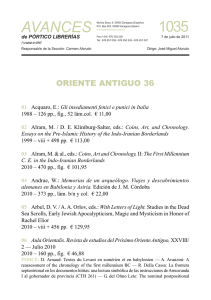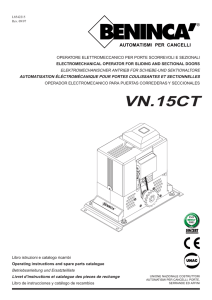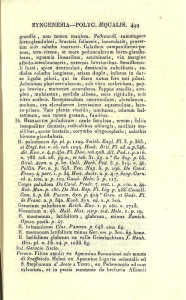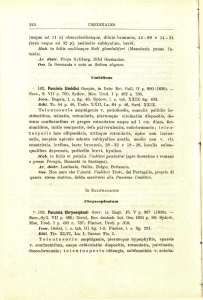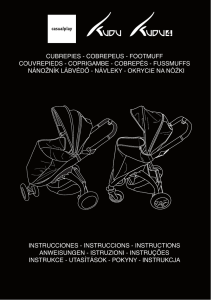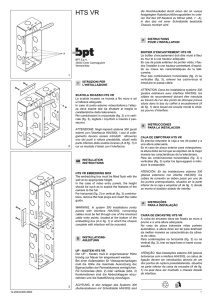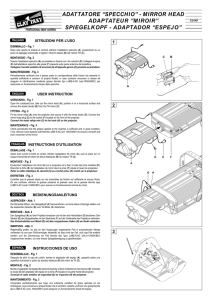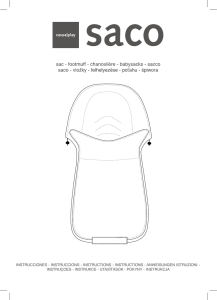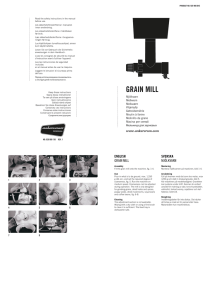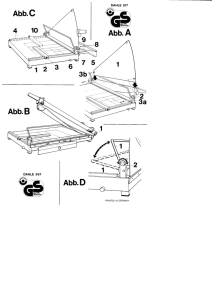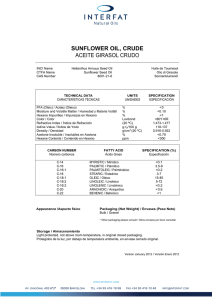Ancient Near East 40
Anuncio
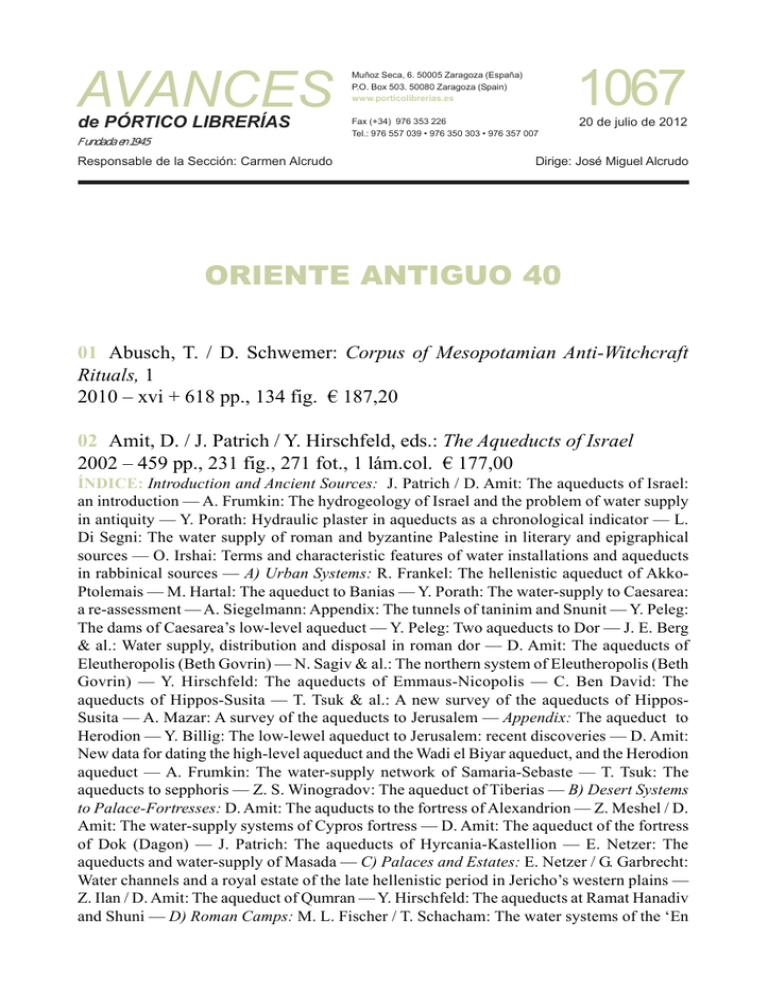
AVANCES de PÓRTICO LIBRERÍAS Fundada en 1945 Responsable de la Sección: Carmen Alcrudo 1067 Muñoz Seca, 6. 50005 Zaragoza (España) P.O. Box 503. 50080 Zaragoza (Spain) www.porticolibrerias.es Fax (+34) 976 353 226 Tel.: 976 557 039 • 976 350 303 • 976 357 007 20 de julio de 2012 Dirige: José Miguel Alcrudo ORIENTE ANTIGUO 40 01 Abusch, T. / D. Schwemer: Corpus of Mesopotamian Anti-Witchcraft Rituals, 1 2010 – xvi + 618 pp., 134 fig. € 187,20 02 Amit, D. / J. Patrich / Y. Hirschfeld, eds.: The Aqueducts of Israel 2002 – 459 pp., 231 fig., 271 fot., 1 lám.col. € 177,00 ÍNDICE: Introduction and Ancient Sources: J. Patrich / D. Amit: The aqueducts of Israel: an introduction — A. Frumkin: The hydrogeology of Israel and the problem of water supply in antiquity — Y. Porath: Hydraulic plaster in aqueducts as a chronological indicator — L. Di Segni: The water supply of roman and byzantine Palestine in literary and epigraphical sources — O. Irshai: Terms and characteristic features of water installations and aqueducts in rabbinical sources — A) Urban Systems: R. Frankel: The hellenistic aqueduct of AkkoPtolemais — M. Hartal: The aqueduct to Banias — Y. Porath: The water-supply to Caesarea: a re-assessment — A. Siegelmann: Appendix: The tunnels of taninim and Snunit — Y. Peleg: The dams of Caesarea’s low-level aqueduct — Y. Peleg: Two aqueducts to Dor — J. E. Berg & al.: Water supply, distribution and disposal in roman dor — D. Amit: The aqueducts of Eleutheropolis (Beth Govrin) — N. Sagiv & al.: The northern system of Eleutheropolis (Beth Govrin) — Y. Hirschfeld: The aqueducts of Emmaus-Nicopolis — C. Ben David: The aqueducts of Hippos-Susita — T. Tsuk & al.: A new survey of the aqueducts of HipposSusita — A. Mazar: A survey of the aqueducts to Jerusalem — Appendix: The aqueduct to Herodion — Y. Billig: The low-lewel aqueduct to Jerusalem: recent discoveries — D. Amit: New data for dating the high-level aqueduct and the Wadi el Biyar aqueduct, and the Herodion aqueduct — A. Frumkin: The water-supply network of Samaria-Sebaste — T. Tsuk: The aqueducts to sepphoris — Z. S. Winogradov: The aqueduct of Tiberias — B) Desert Systems to Palace-Fortresses: D. Amit: The aquducts to the fortress of Alexandrion — Z. Meshel / D. Amit: The water-supply systems of Cypros fortress — D. Amit: The aqueduct of the fortress of Dok (Dagon) — J. Patrich: The aqueducts of Hyrcania-Kastellion — E. Netzer: The aqueducts and water-supply of Masada — C) Palaces and Estates: E. Netzer / G. Garbrecht: Water channels and a royal estate of the late hellenistic period in Jericho’s western plains — Z. Ilan / D. Amit: The aqueduct of Qumran — Y. Hirschfeld: The aqueducts at Ramat Hanadiv and Shuni — D) Roman Camps: M. L. Fischer / T. Schacham: The water systems of the ‘En PÓRTICO LIBRERÍAS AVANCES 1067 — Oriente antiguo 40 2 Boqeq oasis — T. Tsuk: An aqueduct to Legio — E) Fortified Towns and Villages: A. Zertal: The water system of Khirbet el-Hammam (Narbata) — D. Amit / H. Eshel: The water-supply system of H.orvat Kefira — H. Eshel / Z. H. Erlich: The water system in the fortress of Kh. ‘Urmeh-‘Aqraba in E. Samaria — F) Monastic: Y. Hirschfeld: The water supply of the monastery of Chariton — E. Damati: The irrigation systems in the gardens of the monastery of St. Martyrius (Macale Adummim) — G) Mediaeval Agricultural: Z. Ilan: The mediaeval aqueduct to Kefar H.anania and associated installations — R. Frankel & al.: Ancient, mediaeval and modern aqueducts in western Galilee. 03 Annus, A., ed.: Divination and Interpretation of Signs in the Ancient World 2010 – viii + 351 pp. € 25,50 ÍNDICE: A. Annus; On the beginnings and continuities of omen sciences in the ancient world — 1. Theories of Divination and Signs: F. Rochberg: «If P, then Q»: form and reasoning in babylonian divination — J. Allen: Greek philosophy and signs — U. S. Koch: Three strikes and you’re out! A view on cognitive theory and the first-millennium extispicy ritual — E. L. Shaughnessy: Arousing images: the poetry of divination and the divination of poetry — N. Veldhuis: The theory of knowledge and the practice of celestial divination — 2. Hermeneutics of Sign Interpretation: E. Frahm: Reading the tablet, the exta, and the body: the hermeneutics of cuneiform signs in babylonian and assyrian text commentaries and divinatory texts — S. B. Noegel: «Sign, sign, everywhere a sign»: script, power, and interpretation in the ancient Near East —N. P. Heeßel: The calculation of the stipulated term in extispicy — A. Winitzer: The divine presence and its interpretation in early mesopotamian divination — B. Böck: Physiognomy in ancient Mesopotamia and beyond: from practice to handbook — 3. History of Sign Interpretation: S. F. C. Richardson: On seeing and believing: liver divination and the era of warring states (II) — C. Jean: Divination and oracles at the neo-assyrian palace: the importance of signs in royal ideology — J. Scurlock: Prophecy as a form of divination; divination as a form of prophecy — J. Jacobs: Traces of the omen series Šumma izbu in Cicero, De divinatione — 4. Response: M. Nissinen: Prophecy and omen divination: two sides of the same coin. 04 Baffi, F., ed.: Tell Tuqan. Excavations 2008-2010 2011 – 344 pp., fig. € 81,00 05 Bahrani, Z. / Z. Çelik / E. Eldem, eds.: Scramble for the Past. A Story of Archaeology in the Ottoman Empire, 1753-1914 2011 – 519 pp., 177 fig., lám.col. € 56,00 ÍNDICE: Z. Bahrani & al.: Introduction: Archaeology and empire — Interlude: A Late Nineteenth-Century Ottoman Painting and Novella: Y. Hamilakis: Indigenous archaeologies in ottoman Greece — G. Tolias: «An inconsiderate love of the arts»: the spoils of greek antiquities, 1780-1820 — Interlude: An Egyptian Historian Observes British Archaeologists: S. Malley: The Layard enterprise: victorian archaeology and informal imperialism in Mesopotamia — Z. Bahrani: Untold tales of mesopotamian discovery — S. Basch: Archaeological travels in Greece and Asia Minor: on the good use of ruins in nineteenth- PÓRTICO LIBRERÍAS AVANCES 1067 — Oriente antiguo 40 3 century France — R. Ousterhout: The rediscovery of Constantinople and the beginnings of byzantine archaeology: a historiographic survey — H. Laurens: Ernest Renan’s expedition to Phoenicia — Interlude: Osman Hamdi and Ernest Renan: P. Jockey: The Venus de Milo: genesis of a modern myth — U. Makdisi: The «rediscovery» of Baalbek: a metaphor for empire in the nineteenth century — E. Eldem: From blissful indifference to anguished concern: ottoman perceptions of antiquities, 1799-1869 — H. Szemethy: Archaeology and cultural politics: ottoman-austrian relations — Interlude: The Stories Behind a Letter: F. C. Phillip: Ernst Herzfeld and the excavations at Samarra — O. Pancaroglu: A fin-de-siècle reconnaissance of seljuk Anatolia: Friedrich Sarre and his Reise in Kleinasien — Interlude: Halil Edhem on the Museum of Pious Foundations: W. M. K. Shaw: From mausoleum to museum: resurrecting antiquity for ottoman modernity — Z. Çelik: Defining empire’s patrimony: late ottoman perceptions of antiquities — Interlude: The Museum as a Civic Tool. 06 Bar, S. / D. Kahn / J. J. Shirley, eds.: Egypt, Canaan and Israel: History, Imperialism, Ideology and Literature. Proceedings of a Conference at the University of Haifa, 3-7 May 2009 2011 – ix + 370 pp., fig., 6 lám.col. € 133,15 ÍNDICE: S. B.-D. Evian: Shishak’s Karnak relief – more than just name-rings — D. BenTor: Egyptian-canaanite relations in the middle and late bronze ages as reflected by scarabs — S. Binder: Joseph’s rewarding and investiture (Genesis 41:41-43) and the gold of honour in new kingdom Egypt — M. G. Hasel: The battle of Kadesh: identifiying new kingdom polities, places, and peoples in Canaan and Syria — J. K. Hofmeier: David’s triumph over Goliath: 1 Samuel 17:54 and ancient near eastern analogues — S. T. Hollis: Two hymns as praise poems, royal ideology, and history in ancient Israel and ancient Egypt: a comparative reflection — D. Kahn: One step forward, two steps backward: the relations between Amenhotep III, king of Egypt and Tushratta, king of Mitanni — A. Mazar: The egyptian garrison town at Beth-Shean — K. Muhlestein: Levantine thinking in Egypt — M. Müller: A view to a kill: Egypt’s grand strategy in her northern empire — B. Ockinga: Hatshepsut’s appointment as crown prince and the egyptian background to Isaiah 9:5 — B. U. Schipper – Egyptian imperialism after the new kingdom: the 26th dynasty and the southern Levant — J. Shirley: What’s in a title? Military and civil officials in the egyptian 18th dynasty military shpere — C. Vogel: This far and not a step further! The ideological concept of ancient egyptian boundary stelae — A. Zertal: The Arunah pass. 07 Bartoloni, G. / P. Matthiae / L. Nigro / L. Romano, eds.: Tiro, Cartagine, Lixus: nuove acquisizion. Atti del convegno internazinale in onore di Maria Giulia Amadasi Guzzo, Roma, 24-25 novembre 2008 2010 – 279 pp., fig. € 89,40 ÍNDICE: P. Matthiae: Presentazione — G. Barolloni: Introduzione — P. Bartoloni: Nuovi dati sulla cronologia di Sulky — S. F. Bondì: Nora tra i fenici e cartagine — F. Bron: Les estampages du Cabinet du corpus — V. Brouquier-Reddé & al.: L’occupation phénico-punique du quartier dit les temples de Lixus — A. Caubet / M. Yon: Le sanctuaire de KitionBamboula et le contexte stratigraphique des ostraca phéniciens — S. M. Cecchini: Il viaggio PÓRTICO LIBRERÍAS AVANCES 1067 — Oriente antiguo 40 4 di Melqart (?) — J. Desanges: Quelques travaux récents sur la géographie historique de l’Afrique — A. Ferjaoui: Notes toponymiques — E. Gubel: ‘By the rivers of Amurru’. Notes de topographie historique du Akkar - II — A. Hilali: Elyssa, de Tyr à Carthage: quand le mythe rejoint l’histoire — S. Mazzoni: Santuari a Tell Afis nell’età del ferro (I mill. a.C.) e l’architettura templare del Levante — L. Nigro: Il Sacello di Astarte e i culti femminili a Mozia — I. Oggiano: Nuovi dati sul ruolo degli artigiani fenici nella produzione delle anfore in pietra tra Egitto e Levante — R. Rebuffat: Hannon le Césarien — S. Ribichini: Carthago a Cartha — P. Xella: Per un ‘modello interpretativo’ del tofet: il tofet come necropoli infantile? 08 Berlejung, A., ed.: Disaster and Relief Management / Katastrophen und ihre Bewältigung 2012 – vii + 544 pp., fig. € 119,00 ÍNDICE: Introduction: A. Berlejung: Disaster and Relief Management in Ancient Israel/ Palestine, Egypt and the Ancient Near East — I. THEORIES OF DISASTER: E. M. Geenen: Gesellschaftliche Verfügung über Kapitalien und Vulnerabilität in konzeptioneller Perspektive — E. List: Einbruch ins Selbstverständliche. Katastrophen als Kontingenzerfahrung — J. Dietrich: Katastrophen im Altertum aus kulturanthropologischer und kulturphilosophischer Perspektive — II. DISASTER AND RELIEF MANAGEMENT IN ISRAEL/ PALESTINE: 1. Biblical Studies: B. Janowski: Eine Welt ohne Licht. Zur Chaostopik von Jer 4:23-28 und verwandten Texten — S. Grätz: Gericht und Gnade. Die Fluterzählung im Rahmen der biblischen Urgeschichte — T. Römer: The Hebrew Bible as Crisis Literature — J. L. Wright: Die Zerstörung des Ökosystems als Element der Kriegsführung im Alten Israel — D. Edelman: Earthquakes in the Southern Levant. A Literary Topos and a Problem Requiring Architectural Solutions — 2. Archaeological Studies: A. M. Maeir: Philistia and the Judean Shephelah after Hazael and the “Uzziah Earthquake”. The Power Play between the Philistines, Judahites and Assyrians in the 8th Century BCE in Light of the Excavations at Tell es-Safi/Gath — A. A. Burke: Coping with the Effects of War. Refugees in the Levant during the Bronze and Iron Ages — G. Lehmann: Survival and Reconstruction of Judah in the Time of Manasseh — A. M. Bagg: Floods in the Desert. How Nabataeans Managed Catastrophes — III. DISASTER AND RELIEF MANAGEMENT IN EGYPT AND THE ANCIENT NEAR EAST: J. F. Quack: Danaergeschenk des Nil? Zu viel oder zu wenig Wasser im Alten Ägypten — L. D. Morenz: Hungersnöte im Bild. Zur Inszenierung von Topoi im Alten Ägypten — P. A. Kruger: Disaster and the topos of the World Upside Down. Selected Cases from the Ancient Near Eastern World — H. Schaudig: Erklärungsmuster von Katastrophen im Alten Orient — M. Stockhusen: Die Deutung kosmischer Erscheinungen am Beispiel von Sonnen- und Mondeklipsen. Ein Vergleich zwischen den Kulturräumen Mesopotamien und Ägypten im 1. Jt. v.Chr. — J. Klinger: Krankheit und Krieg im Spannungsfeld zwischen mythischer und realer Katastrophe. 09 Bordreuil, P. / D. Pardee / R. Hawley: Une bibliothèque au sud de la ville***. Textes 1994-2002 en cunéiforme alphabétique de la maison d’Ourtenou (Ras Shamra-Ougarit XVIII) 2012 – 270 pp., 1 CD-ROM, fig. € 39,00 PÓRTICO LIBRERÍAS AVANCES 1067 — Oriente antiguo 40 5 10 Briant, P., ed.: Irrigation et drainage dans l’antiquité. Qanats et canalisations souterraines en Iran, en Égypte et en Grèce. Seminairetenu au Collège de France 2001 – 190 pp., fig. € 34,00 11 Bull, C. H. / L. I. Lied / J. D. Turner, eds.: Mystery and Secrecy in the Nag Hammadi Collection and Other Ancient Literature: Ideas and Practices. Studies for Einar Thomassen at Sixty 2011 – xx + 540 pp. € 179,95 ÍNDICE: 1. Mystery and Secrecy in the Nag Hammadi and Related Gnostic Writings: A. D. DeConick: From the Bowels of Hell to Draco: The Mysteries of the Peratics — J.-D. Dubois / F. Ruani: Interprétation d’une formule barbare chez les gnostiques valentiniens d’après le Contre les hérésies d’Irénée, I, 21,3 — K. L. King: Mystery and Secrecy in The Secret Revelation of John — A. Marjanen: Sethian Books of the Nag Hammadi Library as Secret Books — L. Painchaud: «Joseph le charpentier planta un jardin…» (EvPhil 73,8-9): Sens apparent et sens caché dans l’Évangile selon Philippe — A. Pasquier: Invocation et glorification du Nom divin dans le Livre sacré du grand Esprit invisible ou Évangile égyptien (NHC III,2; NHC IV,2) — N. A. Pedersen: The Term µυστηριον in Coptic-Manichaean Texts — M. Scopello: Secrets et révélation dans le codex Tchacos — J. D. Turner: I Tell You a Mystery: From Hidden to Revealed in Sethian Revelation, Ritual, and Protology — 2. Mystery and Secrecy in Other Christian Practices, Text Traditions, and Material Culture: D. Brakke: Mystery and Secrecy in the Egyptian Desert: Esotericism and Evagrius of Pontus — I. Dunderberg: Secrecy in the Gospel of John — D. J. Kyrtatas: Living in Tombs: The Secret of an Early Christian Mystical Experience — H. Lundhaug, Mystery and Authority in the Writings of Shenoute — B. A. Pearson, Mystery and Secrecy in Paul — P.-H. Poirier, Mystère et mystères dans les Actes de Thomas — T. Rasimus: Revisiting the Ichthys: A Suggestion Concerning the Origins of Christological Fish Symbolism — 3. Mystery and Secrecy in Non-Christian Practices, Text Traditions, and Material Culture: J. Bjørnebye: Secrecy and Initiation in the Mithraic Communities of Fourth Century Rome — J. N. Bremmer: Initiation into the Eleusinian Mysteries: A “Thin” Description — C. H. Bull: The Notion of Mysteries in the Formation of Hermetic Tradition — L. I. Lied: Those Who Know and Those Who Don’t: Mystery, Instruction, and Knowledge in 2 Baruch — M. Meyer: The “Mithras Liturgy” as Mystery and Magic — J. P. Sørensen: The Secret Hymn in Hermetic Texts — R. Uro: Cognitive and Evolutionary Approaches to Ancient Rituals: Reflections on Recent Theories and Their Relevance for the Historian of Religion. 12 Callot, O.: Les sanctuaires de l’acropole d’Ougarit. Les temples de Baal et de Dagan (Ras Shamra-Ougarit, 19). Avec un appendice de J.-Y. Monchambert 2011 – 237 pp., 162 fig., 3 lám. € 27,00 13 Chambon, G.: Normes et pratiques: l’homme, la mesure et l’écriture en PÓRTICO LIBRERÍAS AVANCES 1067 — Oriente antiguo 40 6 Mésopotamie, I: Les mesures de capacité et de poids en Syrie ancienne, d’Ebla à Emar 2011 – 200 pp. € 35,00 14 Costa, B. / J. H. Fernández, eds.: Arquitectura defensiva fenicio-púnica. XXII jornadas de arqueología fenicio-púnica (Eivissa, 2007). Coordinador: B. Costa Ribas 2008 – 183 pp., fig., lám. € 25,00 ÍNDICE: H. Pastor Borgoñón: Arquitectura defensiva en Fenicia oriental y en el norte de Israel/Palestina — F. Prados Martínez: La arquitectura defensiva en Cartago y su área de influencia — E. Díes Cusí: Las fortificaciones púnicas de Cerdeña y Sicilia: dos respuestas distintas a dos situaciones diferentes — D. Montanero: Los sistemas defensivos de origen fenicio-púnico del sureste peninsular (siglos VIII-III a.C.): nuevas interpretaciones — J. Blánquez Pérez: Arquitectura defensiva del suroeste de la Península Ibérica. 15 Costa, B. / J. H. Fernández, eds.: De Oriente a Occidente: los dioses fenicios en las colonias occidentales. XII jornadas de arqueología fenicio-púnica (Eivissa, 1997) 1999 – 135 pp., 57 fig., lám. € 10,82 ÍNDICE: J. Sanmartín: Génesis oriental de los dioses fenicios de las colonias occidentales — A. M. Poveda Navarro: Melqart y Astarté en el occidente mediterráneo: la evidencia de la Península Ibérica (siglos VIII-VI a.C.) — M. C. Marín Ceballos: Los dioses de la Cartago púnica — J. Padró: La aportación egipcia a la religión fenicia en occidente — A. M.Vázquez Hoys: Divinidades femeninas romanas en Hispania y sus antecedentes orientales: Diana y Venus. 16 Costa, B. / J. H. Fernández, eds.: Yoserim: La producción alfarera feniciopúnica en Occidente. XXV jornadas de arqueología fenicio púnica (Eivissa, 2010) 2011 – 260 pp., fig. € 30,00 ÍNDICE: A. Delgado Hervás: La producción de cerámica fenicia en el extremo Occidente: hornos de alfar, talleres e industrias domésticas en los enclaves coloniales de la Andalucía mediterránea (siglos VIII-VI a.C.) — A. M. Sáez Romero: Alfarería en el extremo occidente fenicio. Del renacer tardoarcaico a las transformaciones helenísticas — A. M. Niveau de Villedary y Mariñas: La producción alfarera extremo-occidental entre los ss. III y I a.C. Balance historiográfico y estado de la cuestión — J. R. Torres: El sector alfarero de la ciudad púnica de Ibiza — D. Asensio i Vilaró: La presència de ceràmiques púniques ebusitanes al nordest peninsular (segles V-III aC.): impacte econòmic i social de les relacions comercials entre l’Eivissa púnica i els ibers del nord. 17 Diaz i Carbonell, R. M.: Dom Bonaventura Ubach: l’home, el monjo, PÓRTICO LIBRERÍAS AVANCES 1067 — Oriente antiguo 40 7 el biblista 2012 – 252 pp. € 20,00 18 Dimant, D., ed.: The Dead Sea Scrolls in Scholarly Perspective: A History of Research 2012 – xxii + 686 pp. € 207,00 19 Dusek, J.: Aramaic and Hebrew Inscriptions from Mt. Gerizim and Samaria between Antiochus III and Antiochus IV Epiphanes 2012 – xviii + 212 pp. € 103,00 20 Fischer, R.: Die Ahhijawa-Frage. Mit einer kommentierten Bibliographie 2010 – vii + 125 pp. € 31,00 21 Frevel, C., ed.: Mixed Marriages. Intermarriage and Group Identity in the Second Temple Period 2011 – 320 pp. € 104,00 22 Fruyt, M. / M. Mazoyer / D. Pardee, eds.: Grammatical Case in the Languages of the Middle East and Beyond. Acts of the International Colloquium Variations, concurrence et évolution des cas dans divers domaines linguistiques, Paris, 2-4 April 2007 2011 – viii + 419 pp. € 39,00 ÍNDICE: M. Fruyt & al.: Preface — C. Touratier: Cas et analyse en morphèmes? — C. Woods: The conjugation prefixes, the dative case, and the empathy hierarchy in sumerian — D. R. M. Campbell: Agent, subject, patient, and beneficiary: grammatical roles in hurrian — F. MalbranLabat: Des cas en élamite? — P. Fronzaroli: Évolution des cas dans le sémitique archaïque: la contribution de l’éblaïte — R. Hawley: Some case problems in ugaritic — R. Hasselbach: Early canaanite and old aramaic case in the light of language typology — D. Pardee: Vestiges du système casuel entre le nom et le pronom suffixe en hébreu biblique — J. Haudry: Genèse et évolution du système casuel indo-européen: questions et hypothèses — F. Josephson: Allative in indo-european — E. Pirart: Anomalies grammaticales à Bîsotûn — C. Melchert: The problem of the ergative case in hittite — M. Mazoyer: À propos de l’opposition entre le statique et le dynamique en hittite — M. Fritz: Sur l’évolution du locatif en arménien — F. Bader: Énigmes autour du datif et de l’instrumental — V. Martzloff: Les marques casuelles dans les documents paléo-sabelliques et la morphologie du génitif pluriel sud-picénien — P. Poccetti: Formation et variations dans les systèmes flexionnels des langues sabelliques: entre synchronie et diachronie — M. Fruyt: Cas et évolution linguistique en latin — C. Fry: La casualité latine en variation diastratique: du parler populaire à la diction poétique — G. V. M. Haverling: Le PÓRTICO LIBRERÍAS AVANCES 1067 — Oriente antiguo 40 8 flottement entre les cas en latin tardif — M. Cennamo: Case marking of core arguments and alignment in late latin — A. Rousseau: Cas grammaticaux et cas locaux en gotique: les modèles casuels en gotique — P. Guelpa: Remarques sur le datif en islandais moderne — C. Le Feuvre: Mécanismes de réaffectation désinentielle et hiérarchie des oppositions casuelles en slave — S. Sakhno: Pourquoi deux génitifs et deux locatifs en russe pour certains substantifs? Etat actuel des paradigmes et aspects diachroniques — J. Perrot†: Regards sur les cas dans les langues ouraliennes — G.-J. Pinault: Sur l’histoire des cas en tokharien — G. van Heems: Accord sur le désaccord:quelques réflexions sur les rapports entre morphèmes casuels et adpositions en étrusque — G. Gragg: Synthèse: The dynamics of case – recapitulation and future directions. 23 Gachet-Bizollon, J., ed.: Le tell d’Akkaz au Koweït / Tell Akkaz in Kuwait 2011 – 444 pp., 1 CD-ROM, 4 lám.col., 118 fig. € 48,00 24 García Mora, F.: Atlas histórico del Próximo Oriente antiguo, I: De los orígenes a mediados del segundo milenio a.C. 2012 – 149 pp., lám.col. € 25,50 25 García Mora, F.: Atlas histórico del Próximo Oriente antiguo II: De la etapa imperial al mundo persa 2012 – 161 pp., lám.col. € 25,50 26 Garfinkel, Y. / D. Ben-Shlomo / N. Korn: Sha‘ar Hagolan, 3: Symbolic Dimensions of the Yarmukian Culture: Canonization in Neolithic Art 2010 – 404 pp., 34 lám.col. € 81,00 27 Gatier, P.-L. / B. Geyer / M.-O. Rousset, eds.: Entre nomades et sédentaires. Prospections en Syrie du nord et en Jordanie du sud 2010 – 287 pp., fig. € 30,00 ÍNDICE: P.-L. Gatier & al.: Introduction — J. Besançon: Géographie, environnements et potentiels productifs de la région de Pétra (Jordanie) — M. Traboulsi: Les précipitations dans les Marges arides de la Syrie du nord — H. Gonnet: Une stèle hiéroglyphique louvite à Tall Stîb — M.-O. Rousset: Note sur le site de Tall Stîb — J.-B. Yon: UNe bilingue grécopalmyrénienne de la région de cAqîrbât — J.-C. Decourt: Inscriptions grecques de Salamya/ Salamias — M.-O. Rousset: Deux assemblages de céramique hellénistique et romaine de la steppe syrienne — P.-L. Gatier / M.-O. Rousset: Temples romains et mausolées de la Syrie centrale (1) — P.-L. Gatier: Un relief funéraire d’époque romaine à cAqîrbât — C. Duvette: Habitat byzantin dans la steppe: maisons et villages de terre — M. Rivoal: Le peuplement byzantin des massifs basaltiques de la Syrie centrale: modalités d’occupation du sol et stratégies de mise en valeur — M.-O. Rousset: Qanâts de la steppe syrienne — O. Callot: Monnaies trouvées dans les «Marges arides» (Syrie). PÓRTICO LIBRERÍAS AVANCES 1067 — Oriente antiguo 40 9 28 Gosse, B: La constitution du corpus des écritures à l’époque perse, dans la continuité de la tradition biblique 2003 – 238 pp. € 51,00 29 Guetschow, C.: Methoden zur Restaurierung von ungebrannten und gebrannten Keilschrifttafeln - gestern und heute 2012 – 152 pp., 36 lám.col., 24 fig. € 29,00 30 Júnior, M. A., ed.: Fílón de Alexandria nas origens da cultura ocidental 2011 – 133 pp. € 8,00 ÍNDICE: M. A. Júnior: Fílon de Alexandria na interpretação das escrituras — S. Torallas Tovar: La lengua de Fílon de Alejandría en el panorama lingüístico del Egipto romano — T. Faia: Embaixada a Calígula. Augustina Bessa-Luís e uma memória de Fílon de Alexandria — R. M. Duarte: Λογος ενδιαθετος e προφορικος na formação da cristologia patrística — M. Fernandes: O profetismo no tratado De Iosepho de Fílon de Alexandria — C. Motta Rios: Exílio, diáspora e saudades de Jerusalém: estudo em Jeremias 29:1-14 em Fílon de Alexandria — M. Fernandes: Φυσις no tratado de Fílon de Alexandria De Iosepho — M. Alexandre Jr.: Fílon entre os sofistas de Alexandria. A sofística alexandrina sob o olhar crítico de Fílon de Alexandria — S. Pearce: Philo of Alexandria on jewish law and jewish community. 31 Knoppers, G. N. / L. L. Grabbe / D. Fulton, eds.: Exile and Restoration Revisited. Essays on the Babylonian and Persian Periods in Memory of Peter R. Ackroyd 2009 – xi + 225 pp. € 91,00 32 Kriwaczek, P.: Babilonia. Mesopotamia: La mitad de la historia humana 2010 – 416 pp. € 21,90 33 Laneri, N. / P. Pfaelzner / S. Valentini, eds.: Looking North. The Socioeconomic Dynamics of the Northern Mesopotamian and Anatolian Regions During the Late Third and Ealy Second Millennium BC 2012 – vii + 272 pp., 107 fig., 4 lám.col. € 80,00 ÍNDICE: N. Laneri & al.: Introduction — Part I. Environment, Landscape and Settlement Pattern: S. Riehl / K. Deckers: Environmental and Agricultural Dynamics in Northern Mesopotamia during the Early and the Middle Bronze Age — J. Ur: Spatial Scale and Urban Collapse at Tell Brak and Hamoukar at the End of the Third Millennium BC — L. Ristvet: Resettling Apum: Tribalism and Tribal States in the Tell Leilan Region, Syria — P. Pfälzner: The question of Desurbanisation versus Reurbanisation of the Syrian Jazirah in the Late Third and Early Second Millennium BC — L. Cooper: Continuity and Change in the Upper Euphrates Region of Syria — A. Engin / B. Helwing: The EBA-MBA Transition in the Kilis Plain — G. PÓRTICO LIBRERÍAS AVANCES 1067 — Oriente antiguo 40 10 M. Di Nocera: The Beginning of the Second Millennium BC in the Upper Euphrates: Isolation or Strong Regional Identity? — A. Özfirat: Üçtepe and Diyarbakýr Survey: During the Early and Middle Bronze Age — Part II. Site Analysis and Material Culture: A. T. Ökse / A. Görmüs: Analysing an Administrative System: the Case of Salat Tepe in the Upper Tigris Region during the Middle Bronze Age — N. Laneri: Hirbemerdon Tepe: A Middle Bronze Age Site in the Upper Tigris River Valley — G. Kozbe: Evidence for the Societal Complexity of the Upper Tigris Region from the Late Third Millennium/First Half of the Second Millennium BC Occupation of Kavusan Höyük — A. Bianchi: A Diachronic Case? Comparing Pottery Types of the Northern Khabur Triangle and the Upper Tigris Region at the End of the Third Millennium BC — C. Schmidt: The Late Third and Early Second Millennium BC Pottery Tradition in the Syrian Jazirah and Beyond — P. V. Bartl: Giricano and Ziyaret Tepe: Two Middle Bronze Age Sites in the Upper Tigris Region — A. D’Agostino: Hirbemerdon Tepe and the Upper Tigris Valley during the Early Second Millennium BC: A First Assessment of the Local Pottery Horizon — L. S. Dodd: Filling a Niche: Settlement Expansion and Innovation in the Upper Tigris River Valley during the Middle Bronze Age — Z. Wygnañska: Mortuary Practices of the End of the Third and of the Early Second Millennium BC on Tell Arbid (Northeastern Syria): Continuity and Changes — R. Koliñski: “The Mountain Sheep are Sweeter…” — G. M. Schwartz: Conclusion: Northern Exposures: Third to Second Millennium BC Transformations in Upper Mesopotamia. 34 Lange, A. / C. de Troyer, eds.: The Qumran Legal Texts between the Bible and its Interpretation 2011 – xviii + 183 pp. € 49,50 ÍNDICE: A. Lange / K. de Troyer: Introduction — Part 1. The Legal Texts From Qumran and the Hebrew Bible: S. W. Crawford: The Qumran Pentateuch Scrolls: Their Literary Growth and Textual History — I. Himbaza: The Rite of the Blood on the Altar and the Hierarchy of Sacrifices: Qumran Texts, Septuagint and Mishnah as Witnesses to a Law In Evolution — M. Bauks: Jephtas Gelübde und die Unabwendbarkeit Seiner Einlösung — Part 2. The Legal Texts from Qumran and Second Temple Judaism: L. T. Stuckenbruck: The Pentateuch and Biblical Interpretation in the Enoch Literature from the Second Century BCE — E. Otto: Temple Scroll and Pentateuch: A Priestly Debate About the Interpretation of the Torah — S. Paganini: Die Deuteronomische Fassung des Königsgesetzes und Ihre Interpretation Innerhalb der Tempelrolle: Rechtshermeneutische Beobachtungen — B. Dolna: The Hidden and Revealed Torah in Philo and Qumran — Part 3. The Legal Texts from Qumran and Rabbinic Judaism: L. H. Schiffman: Light from the Qumran Scrolls on Rabbinic Literature — G. Stemberger: Mishnah and Dead Sea Scrolls: a Reflection On Continuity and Change — H. K. Harrington: Examining Rabbinic Halakha Through the Lens of Qumran. 35 Lebeau, M., ed.: Associated Regional Chronologies for the Ancient Near East and the Eastern Mediterranean: Arcane, 1: Jezirah 2012 – viii + 442 pp., fig., tabl. € 116,50 ÍNDICE: M. Lebeau: Introduction — P. Quenet: Stratigraphy — E. Rova: Pottery — J.-W. Meyer: Urbanisation & City Planning — P. Pfälzner: Architecture — A. Bianchi & K. Franke: Metal — A. Pruss: Figurines — J. Thomalsky: Lithics & Stone Industry — S. Calentini: PÓRTICO LIBRERÍAS AVANCES 1067 — Oriente antiguo 40 11 Burials & Funerary practices — A. McCarthy: Glyptic — L. Ristvet: Radiocarbon — W. Sallaberger: History & Philology — M. Lebeau: Conclusion. 36 Lebeau, M. / A. Suleiman, eds.: Tell Beydar. The 2004/2-2009 Seasons of Excavations, the 2004/2-2009 Seasons of Architectural Restoration. A Preliminary Report 2012 – 302 pp., fig. € 94,00 37 Lundberg, M. J. / S. Fine / W. T. Pitard, eds.: Puzzling Out the Past. Studies in Northwest Semitic Languages and Literatures in Honor of Bruce Zuckerman 2012 – xvi + 334 pp., fig., lám.col. € 183,10 ÍNDICE: A. Azzoni: “Where Will Yehoyišma’ Go?”: A Reconsideration of TAD B3.8 — J. Bitton & al.: Yet Another Jewish Tombstone from Late Antique Zoar/Zoora: The Funerary Marker of Hannah Daughter of Levi — E. Cook: 4Q541, Fragment 24 Reconsidered — C. Dobbs-Allsopp: Space, Line, and the Written Biblical Poem in Texts from the Judaean Desert — A. Faust / E. Eshel: An Inscribed Bulla with Grazing Doe from Tel ‘Eton — Z. Garber: Torah and Testament: Teaching and Learning Scripture in Dialogue and in Hermeneutics — E. Greenstein: Methodological Principles in Determining that the So-Called Jehoash Tablet is Inauthentic — S. Kaufman: Gleanings from the Comprehensive Aramaic Lexicon I: Previously Unknown Syriac Words — T. Lewis: Job 19 in the Light of the Ketef Hinnom Inscriptions and Amulets — M- J. Lundberg: New Drawings and Photographs of Four Cypriot Inscriptions — P. K. McCarter, Jr.: An Inscribed Arrowhead of a Crown Prince of Babylon — S. PaulJonah 2:7—The Descent to the Netherworld — W. Pitard: Nodding Scribe and Heavy Thumb: New Readings in CAT 1.14 — A. Rainey: New Lighting on the Amarna Letters — C. Rollston: An Old Hebrew Stone Inscription from the City of David: A Trained Hand and a Remedial Hand on the Same Inscription — M. Smith: Why was ‘Old Poetry’ Used in Hebrew Narrative? Historical and Cultural Considerations about Judges 5 — L. S. Dodd: Squeezing Blood from a Stone: The Archaeological Context of the Incirli Inscription — Z. Zevit: Mesha’s ryt in the Context of Moabite and Israelite Bloodletting. 38 Madreiter, I.: Stereotypisierung - Idealisierung - Indifferenz. Formen der Auseinandersetzung mit dem Achaimeniden-Reich in der griechischen Persikaliteratur 2012 – xvi + 237 pp. € 70,75 ÍNDICE: Einleitende Vorbemerkungen — Sozialpsychologische und literaturwissenschaftliche Ansätze zur Erforschung von Fremdwahrnehmung — Ktesias von Knidos: Persien als dystopische Projektionsfläche griechischer Vorstellungen — Persika in der Nachfolge des Ktesias I: Dinon von Kolophon — Persika in der Nachfolge des Ktesias II: Herakleides von Kyme — Die Intentionen Dinons und Herakleides — Synthese und Ausblick: Das PerserImagotyp im sozio-politischen Kontext des vierten Jahrhunderts — Zusammenfassung und Ergebnisse. PÓRTICO LIBRERÍAS AVANCES 1067 — Oriente antiguo 40 12 39 Malley, S.: From Archaeology to Spectacle in Victorian Britain. The Case of Assyria, 1845-1854 2012 – 220 pp., 36 fig. € 71,50 40 Maul, S. M. / R. Strauss: Ritualbeschreibungen und Gebete I. Mit Beiträgen von D. Schwemer 2011 – xi + 240 pp., fig. € 49,95 41 Mimouni, S. C.: Le judaïsme ancien du VIe siècle avant notre ère au IIIe siècle de notre ère: des prêtres aux rabbins 2012 – 968 pp. € 49,00 Nouvelle clio. 42 Nigro, L. ed.: Motya and the Phoenician Ceramic Repertoire Between the Levant and the West, 9th-6th Century BC. Proceedings of the International Conference Held in Rome, 26th February 2010 2010 – xix + 253 pp., fig., lám.col. € 146,60 ÍNDICE: P. Bartoloni: La ceramica fenicia e punica: problemi e prospettive — L. Nigro: Alle origini di Mozia: stratigrafia e ceramica del tempio del Kothon dall’VIII al VI secolo a.C. — F. J. Núñez Calvo: Referencias secuenciales del repertorio cerámico fenicio metropolitano de la edad del hierro tardío — B. Bechtold / R. Docter: Transport amphorae from punic Cathage: an overview — a. Catalbiano / F. Spagnoli: Mozia: la ceramica fenicia arcaica dal sondaggio stratigrafico III nella zona D — M. Botto: La ceramica fenicia dall’Etruria e dal Latium vetus — M. Guirguis: Il repertorio ceramico fenicio della Sardegna: differenziazioni regionali, specificità evolutive — J. R. Torres: La cerámica fenicia del Mediterráneo extremo-occidental y del Atlántico (s. VIII-1R. 1/3 del VI aC). Problemas y perspectivas actuales. 43 Orlamünde, J.: Die Obeliskenfragmente aus Assur. Mit einem Beitrag zu den Inschriften von E. Frahm 2011 – viii + 97 pp. + 53 lám., 4 plan. € 66,00 44 Ossendrijver, M.: Babylonian Mathematical Astronomy: Procedure Texts 2012 – xxvi + 616 pp., 76 fig., 113 lám.col. € 117,65 45 Ovadiah, A. / Y. Turnheim: Roman Temples, Shrines and Temene in Israel 2011 – xii + 155 pp., 128 lám. € 187,20 46 Paganini, S. / C. Paganini: Qumran, les ruines de la discorde. Com- PÓRTICO LIBRERÍAS AVANCES 1067 — Oriente antiguo 40 13 plots, hypothèses, invraisemblances au défi de l’archéologie 2012 – 298 pp. € 19,00 47 Peilstocker, M. / A. A. Burke, eds.: The History and Archaeology of Jaffa, 1 2011 – 294 pp., 100 fig., lám.col. € 59,80 48 Popovic, M., ed.: The Jewish Revolt against Rome. Interdisciplinary Perspectives 2011 – xii + 472 pp. € 148,75 ÍNDICE: M. Popoviæ: The Jewish Revolt against Rome: History, Sources and Perspectives — G. Woolf: Provincial Revolts in the Early Roman Empire — W. Eck: Die römischen Repräsentanten in Judaea: Provokateure oder Vertreter der römischen Macht? — A. M. Berlin: Identity Politics in Early Roman Galilee — B. Schultz: Not Greeks but Romans: Changing Expectations for the Eschatological War in the War Texts from Qumran — J. S. McLaren: Going to War against Rome: The Motivation of the Jewish Rebels — S. Mason: What is History? Using Josephus for the Judaean-Roman War — J. W. van Henten: Rebellion under Herod the Great and Archelaus: Prominent Motifs and Narrative Function — J. Wilker: Josephus, the Herodians and the Jewish War — D. R. Schwartz: Josephus on Albinus: The Eve of Catastrophe in Changing Retrospect — P. W. van der Horst: Philosophia epeisaktos: Some Notes on Josephus, A.J. 18.9 — U. Rappaport: Who Were the Sicarii? — J. Magness: A Reconsideration of Josephus’ Testimony about Masada — R. Deutsch: Coinage of the First Jewish Revolt against Rome: Iconography, Minting Authority, Metallurgy — D. T. Ariel: Identifying the Mints, Minters and Meanings of the First Jewish Revolt Coins — J. J. Price: The Jewish Population of Jerusalem from the First Century B.C.E. to the Early Second Century C.E.: The Epigraphic Record — G. H. van Kooten: The Jewish War and the Roman Civil War of 68–69 C.E.: Jewish, Pagan, and Christian Perspectives. 49 Porter, A.: Mobile Pastoralism and the Formation of Near Eastern Civilizations. Weaving Together Society 2012 – x + 389 pp., 33 fig., 5 tabl. € 80,10 ÍNDICE: Introduction —The problem with pastoralists — Wool, writing, and religion — From temple to tomb — Tax and tribulation, or, who were the Amorrites? — Conclusion. 50 Potts, D. T., ed.: A Companion to the Archaeology of the Ancient Near East, 2 vols. 2012 – lii + 1.445 pp., 4 map., fig. Precio de lanzamiento hasta el 31.08.2012 € 260,00 • Después € 305,05 ÍNDICE: VOLUME I. Part I. The Framework: T. J. Wilkinson: Introduction to the geography, climate, topography and hydrology of the ancient Near East — M. B. Garrison: Antiquarianism, copying, collecting — N. Chevalier: Early excavations (pre-1914) in the Near PÓRTICO LIBRERÍAS AVANCES 1067 — Oriente antiguo 40 14 East — P. Magee: The foundations of antiquities departments — R. Bernbeck: The political dimension of archaeological practices: The case of the «Ancient Near East» — O. W. Muscarella: The antiquities trade and the destruction of ancient Near Eastern cultures — Part II. Late Pleistocene and Early Holocene Hunters and Gatherers: A. H. Simmons: Late Pleistocene and early Holocene hunters and gatherers: The Levant — K. Schmidt: Late Pleistocene and Early Holocene hunters and gatherers: Anatolia — Part III. Developments in Farming, Animal Husbandry and Technology: G. Willcox: The beginnings of cereal cultivation and domestication in southwest Asia — M. Tengberg: Fruit-growing in the ancient Near East — B. S. Arbuckle: Animals in the ancient world — D. T. Potts: Fish and fishing in the ancient Near East — S. A. Rosen: Lithic industries in the Near East during the Holocene period — A. M. Bagg: Irrigation — C. A. Petrie: Ceramic production — L. Weeks: Metallurgy — W. Reade: Glass — I. Good: Textiles in the ancient Near East — R. A. Carter: The watercraft of the ancient Near East — Part IV. Varieties of Early Village and Town life: K. Bartl: Varieties of early village and town life: The Northern Levant — E. B. Banning: Varieties of early village and town life: The Southern Levant — S. Campbell: Varieties of early village and town life: Northern Mesopotamia — D. Baird: The late Epipalaeolithic, Neolithic and Chalcolithic of the Anatolian Platteau, 13,000-4000 BC — J. Oates: Early village and town life in southern Mesopotamia — P. Drechsler: Varieties of early village and town life: The Arabian peninsula — B. Helwing: Varieties of early village and town life: The Iranian plateau — A. Moghaddam: Varieties of early village and town life: Southwestern Iran — VOLUME II. Part V. Bronze Age Cities of the Plains and the Highlands: J. Ur: Bronze Age cities of southern Mesopotamia — T. Matney: Bronze Age cities of northern Mesopotamia — C. Bachhuber: Bronze Age cities on the Anatolian plateau — C. P. Thornton: Bronze Age cities of Iran — H. Genz: Bronze Age cities of the Northern Levant — T. P. Harrison: Bronze Age cities of the Southern Levant — Part VI. The Archaeology of Empire: A. McMahon: The Akkadian period: Empire, environment and imagination — A. T. Smith: The Caucasus and the Near East — M. D. Frachetti / L. M. Rouse: Central Asia, the steppe and the Near East, 2500-1500 BC — M. Heinz: The Ur III, Old Babylonian and Kassite Empires — T. Bryce: The Hittite Empire — J. Álvárez-Mon: Elam: Iran’s first empire — G. L. Possehl: India’s relations with western empires (2300-600 BC) — P. Pfälzner: Levantine kingdoms of the Late Bronze Age — A. C. Gunter: Neo-Hittite and Phrygian kingdoms of North Syria and Anatolia — A. Hausleiter: North Arabian kingdoms — T. Hikade: Egypt and the Near East — F. Pedde: The Assyrian heartland — B. J. Parker: The Assyrians abroad — A. Ayvazian: The Urartian Empire — C. H. Roosevelt: Iron Age western Anatolia: The Lydian Empire and Dynastic Lycia — H. D. Baker: The Neo-Babylonian Empire — W. F. M. Henkelman: The Achaemenid heartland: An archaeological-historical perspective — L. Khatchadourian: The Achaemenid provinces in archaeological perspective — L. Hannestad: The Seleucid Kingdom — S. R. Hauser: The Arsacid (Parthian) Empire — B. Fischer-Genz: Roman rule in the Near East — S. E. Sidebotham: The Red Sea and Indian Ocean in the age of the great empires — B. Hamarneh: Byzantium in Asia Minor and the Levant — A. Mousavi / T. Daryaee: The Sasanian Empire: An archaeological survey (c. 220640 AD) — C. Horn / E. C. D. Hunter: Christianity in the Late Antique Near East — Bibliography. 51 Prechel, D. / H. Freydank: Mittelassyrische Rechtsurkunden und PÓRTICO LIBRERÍAS AVANCES 1067 — Oriente antiguo 40 15 Verwaltungstexte, X 2011 – ix + 85 pp., 91 fig., tabl., 9 lám. € 58,25 52 Remedios, S. / F. Prados / J. Bermejo, eds.: Aníbal de Cartago. Historia y mito 2012 – 537 pp., fig. € 25,00 ÍNDICE: D. Marzoli: Prólogo — Introducción: S. Remedios & al.: Aníbal desde el siglo XXI — 1. El mundo de Aníbal: J. M. Blázquez Púnica: La herencia de Amílcar Barca (290229 a.C.) y de Asdrúbal (245-221 a.C.) a Aníbal (247/246-183 a.C.): La segunda guerra púnica — A. Rey da Silva: Mar y guerra en el Mediterráneo antiguo: las marinas romanas y cartaginesa en el siglo III a.C. — V. García Coca: La ciudad en época de Aníbal. Urbanismo y arquitectura en la Cartago helenística — R. Rodríguez Muñoz: La religión fenicia en la Península Ibérica durante la segunda guerra púnica — F. Prados Martínez: La muerte y los ritos funerarios en tiempos de Aníbal — 2. Aníbal, strategos: P. Barceló: Aníbal y la helenización de la guerra en Occidente — A. J. Domínguez Monedero: Los otros Barca: los familiares de Aníbal — S. Remedios Sánchez: La campaña contra los vacceos — P. Jiménez: Mercenarios de la Península Ibérica en las tropas de Aníbal — C. González Wagner: El sufetato de Aníbal — J. J. Ferrer Maestro: Las cuentas de Aníbal — 3. Aníbal a través de la arqueología: M. Bendala Galán: La recuperación arqueológica de la acción de los Barca: logros y expectativas — J. L. López Castro / V. Martínez Hahnmüller: Baria en la segunda guerra romano-cartaginesa: su papel histórico a través de la documentación literaria y arqueológica — J. P. Bellón Ruiz & al.: Un escenario bélico en la segunda guerra púnica: Baecula — F. J. García Fernández: Cartago a las puertas: Turdetania en los albores de la segunda guerra púnica — 4. Aníbal, la leyenda: M. P. García-Bellido: Los retratos de la dinastía bárquida en las monedas de Iberia — D. Álvarez Jiménez: Aníbal vándalo y la «cuarta guerra púnica»: el uso del recuerdo púnico en el contexto del conflicto vándalorromano — H. Jiménez Vialás: Aníbal en la cultura europea. De Dante a Flaubert (ss. XIV-XIX) — S. Ben Tahar: Quelques témoignages sur la survivance de la mémoire d’Hannibal au pays de Carthage. 53 Ruzicka, S.: Trouble in the West. Egypt and the Persian Empire, 525-332 BCE 2012 – xxv + 311 pp., 5 fig., 5 map. € 56,65 ÍNDICE: Introduction: Stories and Sources — Persia and Egypt: The Historical Perspective — Persian Success: Conquest and Kingship, 525-518 — Managing Egypt, 518-415 — Losing Egypt, 415-400 — Securing the Eastern Mediterranean, 399-395 — Into the Aegean, 394-392 — To Egypt: Preparations and Campaign, 392-387 — The Egyptian War and the King’s Peace, 387-386 — Egypt Strikes Back: The Cypriot War and the Struggle for the Eastern Mediterranean, 386-379 — Iphicrates Takes Over, ca. 378-373 — Pharnabazus and Iphicrates’ Egyptian Campaign — Court Politics and the Collapse of the Third Campaign, 372-365 — Egyptian Strategy Shifts: The Genesis of Tachos’ Great Offensive, 364-361 — Tachos: Campaign and Collapse, 360-359 — Persian Counterattack? — Artaxerxes III: King and Commander, 358- PÓRTICO LIBRERÍAS AVANCES 1067 — Oriente antiguo 40 16 350 — Loss and Recovery of the Middle Territory, 350-345 — Persian Success, 344-343 — From Artaxerxes III to Alexander III — East, West, and Far West after the Persians: The Long View — Appendices: A) King Lists, Egypt and Persia — B) Timeline, 525 - 332 B.C. 54 Saporetti, C.: Prestiti privati dei mezzi ufficiali di scambio nel periodo medio-assiro. Con la collaborazione di G. Matini 2012 – 213 pp. € 14,60 55 Sassoon, I. S. D.: The Status of Women in Jewish Tradition 2011 – 232 pp. € 55,45 ÍNDICE: Part I. Monogamy: The sources — Pro-CD arguments — Anti-CD arguments — Indeterminate arguments — Make-or-break argument — Which way does the evidence point? — Gen. 1:27–29 revisited — Part II. Commandments (Misvot): Zeman gerama — Derekh — The scriptural evidence — Deuteronomy: a pattern — The priestly Torah — Two writers on purity law — Torah study — Part III. Intrinsic Equality: The Qatlanit law — ‘Rankings’ of Horayot 3:7 — Venus and Mars — Covenant — Gauging purity’s weight in p — Body and soul — Conclusion. 56 Schmid, K.: The Old Testament. A Literary History 2012 – xiv + 321 pp. € 43,00 ÍNDICE: Purpose, history, and problems of a literary history of the Old testament — The beginnings of ancient Israel’s literature among the syro-palestinian city-states before the advent of the assyrians (tenth-eighth centuries B.C.E.) — The literature of the assyrian period (eighthseventh centuries B.C.E.) — The literature of the babylonian period (sixth century B.C.E.) — The literature of the persian period (fifth-fourth centuries B.C.E.) — The literature of the ptolemaic period (third century B.C.E.) — The literature of the seleucid period (second century B.C.E.) — Becoming scripture and the genesis of the canon. 57 Schneider, T. J.: An Introduction to Ancient Mesopotamian Religion 2011 – x + 146 pp. € 15,60 58 Seri, A.: Local Power in Old Babylonian Mesopotamia 2012 – xvi + 240 pp. € 26,00 59 Shayegan, M. R.: Aspects of History and Epic in Ancient Iran. From Gaumata to Wahnam 2012 – 240 pp., 5 fig., 8 fot., 9 tabl. € 23,85 60 Silverman, J. M.: Persepolis and Jerusalem. Iranian Influence on the Apocalyptic Hermeneutic 2012 – 320 pp., 16 fig. € 97,50 PÓRTICO LIBRERÍAS AVANCES 1067 — Oriente antiguo 40 17 61 Sokoloff, M.: A Dictionary of Jewish Babylonian Aramaic of the Talmudic and Geonic Periods 2002 – 1.582 pp. € 166,40 62 Sokoloff, M.: A Dictionary of Jewish Palestinian Aramaic of the Byzantine Period 20022 rev. – vii + 848 pp. € 119,60 63 Sokoloff, M.: A Dictionary of Judean Aramaic 2003 – 88 pp. € 27,00 64 Stavrakopoulou, F.: Land of Our Fathers. The Roles of Ancestor Veneration in Biblical Land Claims 2010 – 208 pp. € 78,00 65 Steimer-Herbet, T., ed.: Pierres levées, stèles anthropomorphes et dolmens / Standing Stones, Anthropomorphic Stelae and Dolmens 2011 – 210 pp., fig. € 45,50 ÍNDICE: W. A. Azizeh: Structures cultuelles et funeraires des IV et III millenaires dans le Sud jordanien desertique: l’occupation de la region d’al-Thulaythuwat — A menhir discovered at Wadi es-Saqra, Amman district (Jordan) —H. G. Scheltema: Standing stones in Jordan: some remarks on occurrence, typology and dating — A. Armendariz et al.: The megalithic necropolises to the west of Homs (Syria) — C. Castel: Al-Rawda et le culte des pierres dressees en Syrie a l’age du Bronze — P. M. Zehil Michel: Pierres dressees, betyles, urbanisme et espace religieux a Mari: nouvelles recherches au ‘massif rouge’ (Syrie, 2006-2007) — J. A .Fernández-Tresguerres Velasco: Pierres dressees dans la region do Mutawwaq (Jordanie) — Z. A. Kafafi: Upright Stones of the Neolithic Village ‘Ayn Ghazal: Location and Function — Jordan) — G. O. Rollefson: Praising the Almighty: Late Prehistoric Desert Sanctuaries in Wadi Ramm (Jordan) — L. Khalidi / E. Keall: Late prehistoric standing stones of the Tihamah coastal plain, Yemen: cumulative review — J. McCorriston: Anthropomorphic stelae in ancient Hadramawt (Yemen) — J. Bradbury / G. Philip: The world beyond the tells: pre-classical activity in the basalt landscape of the Homs region, Syria — C. Nicolle: Qui dresse des pierres au Proche-Orient? — L. Marti: Pierres levees et monuments commemoratifs: l’apport des textes de l’Euphrate syrien. 66 Stein, P.: Die altsüdarabischen Minuskelinschriften auf Holzstäbchen aus der bayerischen Staatsbibliothek in München, Band 1: Die Inschriften der mittel- und spätsabäischen Periode, 2 vols. (Text + Verzeichnisse und Tafeln) 2010 – 764 pp. + 190 lám., despl. € 138,60 PÓRTICO LIBRERÍAS AVANCES 1067 — Oriente antiguo 40 18 67 Stoekl, J.: Prophecy in the Ancient Near East. A Philological and Sociological Comparison 2012 – xvi + 298 pp. € 114,40 ÍNDICE: Introduction — I. Prophecy in Old Babylonian Sources: Introduction to Old Babylonian Prophecy — Old Babylonian Prophets — The Prophetic Message — Further Aspects of Old Babylonian Prophecy — Conclusions — II. Prophecy in Neo-Assyrian Sources: Introduction to Neo-Assyrian Prophecy — Neo-Assyrian Prophets — The Message — Other Aspects of Neo-Assyrian Prophecy — Conclusions — III. Prophecy in the Hebrew Bible: Introduction to Prophecy in the Hebrew Bible — The Messengers — Conclusions — IV. Comparison and Conclusion: Comparison of Old Babylonian, Neo-Assyrian and Biblical Prophecy — Conclusions. 68 Streck, M. P., ed.: Die Keilschrifttexte des altorientalischen Instituts der Universität Leipzig 2011 – vii + 116 pp. + 45 lám. € 41,00 69 Studi epigrafici e linguistici sul Vicino Oriente antico (SEL), 27 — 2010 2010 – 116 pp. € 26,00 ÍNDICE: F. Israel: Ricordo di Maurice Sznycer — P. Xella: Maurice Sznycer: postilla autobiografica — G. Minunno: Sull’Arad mitanguranni come documento storico-religioso — J. Tropper / J.-P. Vita: Die ugaritische Gefäßbezeichnung spl/saplu und die Rechtsurkunde RS [Varia 31] — P. Xella: Sull’etimologia di (Baal) Hammon — P. C. Schmitz: Late punic words for textiles and their production — P. C. Schmitz: The large punic inscription (KAI 59) from Henchir Medine (Althiburus) translated and interpreted — Il progetto internazionale «Dizionario enciclopedico della civiltà fenicia»: P. Xella: Il progetto del «Dizionario» e gli studi fenici — S. F. Bondì: Considerazioni generali — V. Melchiorri: Il repertori dei toponimi — J. A. Zamora López: Algunas consideraciones al respecto del tratamiento de la toponimia de la Península Ibérica (y sus alrededores relacionados) en el DECF — G. Garbati: Aspetti e problemi delle c.d. macrovoci: «Luoghi di culto», «Mondo funerario», «Architettura e urbanistica» — T. Pedrazzi: Problemi di definizione e strutturazione delle macrovoci «Arte e artigianato» e «Iconografia e iconologia» — A. Ercolani: Lemmatizzare gli autori classici: considerazioni preliminari — S. Ribichini: Filone e i suoi dèi. Problemi e soluzioni per un’ottantina di lemmi — F. Mazza: Alcune riflessioni sul metodo e sulla struttura — Recensioni e schede bibliografiche. 70 Tappy, R. E. / P. K. McCarter Jr., eds.: Literate Culture and Tenth-Century Canaan. The Tel Zayit Abecedary in Context 2008 – xii + 140 pp., 1 comp., fig. € 39,00 71 Treadwell, L.: Craftsmen and Coins: Signed Dies in the Iranian World (Third to the Fifth Centuries AH) 2011 – 124 pp., fig. € 32,60 PÓRTICO LIBRERÍAS AVANCES 1067 — Oriente antiguo 40 19 72 Ur, J. A.: Tell Hamoukar, 1: Urbanism and Cultural Landscapes in Northeastern Syria. The Tell Hamoukar Survey, 1999-2001 2010 – lii + 384 pp., despl., fig. € 72,80 73 Wiesehöfer, J. / T. Krüger, eds.: Periodisierung und Epochenbewusstsein im Alten Testament und in seinem Umfeld 2012 – 155 pp. € 43,70 ÍNDICE: Reiche, Dynastien … und auch Chroniken? — J. F. Quack: Zum Bewusstsein der eigenen Vergangenheit im Alten Ägypten — M. van de Mieroop: The Mesopotamians and their Past — J. Wiesehöfer / R. Rollinger: Periodisierung und Epochenbewusstsein in achaimenidischer Zeit — R. Bichler: Über die Periodisierung griechischer Geschichte in der griechischen Historie — G. N. Knoppers: Periodization in Ancient Israelite Historiography: Three Case Studies. 74 Yona, S., ed: Or Le-Mayer. Studies in Bible, Semitic Languages, Rabbinic Literature, and Ancient Civilizations. Presented to Mayer Gruber on the Occasion of his Sixty-Fifth Birthday 2010 – 681 pp. € 58,00 75 Zeilfelder, S.: Hittite Exercise Book. English Translation by E.-M. Wagner 20102 rev. – viii + 309 pp. € 30,50 76 Ziolkowski, T.: Gilgamesh Among Us. Modern Encounters with the Ancient Epic 2011 – xvi + 226 pp., 4 fig. € 27,95 ***
